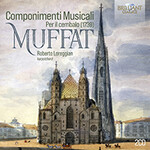
Muffat: Componimenti Musicali per il cembalo
 $30.00
Out of Stock
$30.00
Out of Stock6+ weeks add to cart
GOTTLIEB MOFFAT
Muffat: Componimenti Musicali per il cembalo
Roberto Loreggian (harpsichord)
[ Brilliant Classics / 2 CD ]
Release Date: Friday 2 February 2024
This item is currently out of stock. It may take 6 or more weeks to obtain from when you place your order as this is a specialist product.
Gottlieb Muffat's oeuvre, dedicated almost in its entirety to keyboard instruments and skilfully straddling the stile antico and stile moderno, deserves more detailed attention than it has ever been afforded. The majority of sources containing music by Muffat are unpublished, with only two collections published at the composer's own behest during his years in the Emperor's service in Vienna. One of these is the Componimenti Musicali per il Cembalo (Augsburg, 1739).
This collection contains 6 Suites and a Ciacona with 38 variations for solo harpsichord. The composer describes these seven works as capricci or galanterie to be performed in the stile moderno and to suit modern tastes. Although arranged in the conventional order of Allemande-Courante-Sarabande-Gigue, Muffat also added various optional dances, displaying no shortage of innovation. The first movements are introductory in nature, often fugal in form and varying in style and pace: Ouverture (Suites 1 and 5), Prelude (Suite 2) and Fantaisie (Suites 3, 4 and 6). The seventh piece in the collection, the Ciacona con 38 Variazioni, is a special case. As Christopher Hogwood suggests in his introduction to the modern edition (Orpheus, 2009), the Ciacona could be another tribute to the imperial family, as the number of variations matches the age Charles VI's niece, Maria Amalia, would have been on 22 October 1739.
Muffat's interest in contemporary harpsichord composition is most clearly evident in his transcription and reinterpretation of works by George Frideric Handel, based on a manuscript copy of the Suites des pièces pour le clavecin he held in his library. Muffat reworked the suites in Handel's collection, suggesting new ornamentation, distributing the notes differently between the hands, changing the clefs and sometimes note values, and adding slurs and cadenzas. He then applied everything he had observed while rewriting Handel's suites to his own Componimenti musicali: including a table of ornaments, which the composer asks be played with 'art and discretion'; he considers the positioning of the player's hands on the keyboard in his writing and avoids using multiple clefs on one line to prevent confusion; he describes the optimum way to use the thumb for accidentals; and he provides the correct technical interpretation of trills and slurs.
Study of the Componimenti reveals what could be defined as a pedagogical intent, as well as a clear desire to make the score unambiguous and accessible by means of his introductory instructions. The collection contributed greatly to setting a new benchmark for keyboard writing in the lands of the Viennese Empire.
Tracks:
Suite No. 1 in C Major
Suite No. 2 in G Minor
Suite No. 3 in D Major
Suite No. 4 in B-Flat Major
Suite No.5 in D Minor
Suite No. 6 in G Major
Ciacona in G Major